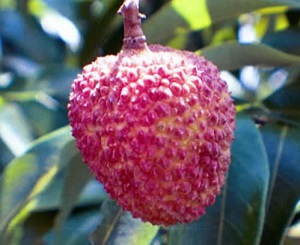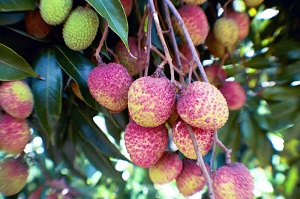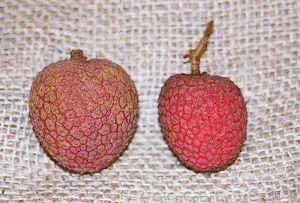From Lychees Online
by Krystal Folino and Bill Mee
'Hak Ip'

Fig. 1
'Hak Ip' close-up
The
'Hak Ip' is a relatively recent introduction into South Florida. This
fruit embodies almost every desirable characteristic in a lychee:
superb flavor, large size, small seed and nice coloration.

Fig. 2 
'Hak Ip' lychee fruit ripening
This
'Hak Ip'' fruit has some fruit that is almost ripe ready to be picked
(Fig. 2). Other fruit on the cluster is still small and green. In our
opinion the 'Hak Ip' is not as sweet as the 'Brewster' at peak
ripeness; however that does not detract from the delicious flavor. The
skin of the 'Hak Ip' is thicker than the 'Brewster' and it retains more
bumpiness even at the end of the ripening process.
 |
 |
Fig. 3 
'Hak Ip' left, 'Brewster' right |
Fig. 4 
Cross section of 'Hak Ip' left, 'Brewster' right |
Notice
the size of a ripe 'Hak Ip' fruit (left) compared to a ripe Brewster
(right). Depending on the amount of rainfall, the 'Brewster' fruit can
grow as large as 'Hak Ip' and 'Emperor'. Both are very delicious, but
the Haak yip seems to be rated the best by most everyone who tastes
one. The only problem being that Haak yips are very shy bearing trees.
This
photo (Fig. 4) shows a cross section of the same two fruit. The 'Hak
Ip' is on the left and the 'Brewster' is on the right. You will note
the amount of flesh in the 'Hak Ip' and the chicken tongue seed.
It is easy to understand why growers raced to plant out groves of 'Hak
Ip' after this variety became available.
In
nearly ten years our 'Hak Ip' trees have not produced much in the way
of fruit; however experience has demonstrated that it can take many
years for a lychee tree to come into full production and several
factors such as fertilization, soil pH, moisture and seasonal climate
variations can influence the productivity of lychee trees.
by Bill Mee and Krystal Folino - Lychees Online
Back to
Lychee Page
|
|




